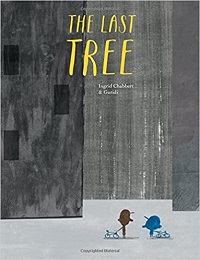| ________________
CM . . .
. Volume XXIII Number . . . .March 17, 2017
excerpt:
And the stories the father told his young son were about the freedom he had as child, the freedom to play with his best friend in open, grass-filled fields where, barefoot, they could fly kites and engage in other fun activities. The father’s verdant childhood world is not that being experienced by the son who lives in a city of “... roads, walls and lots of other ugly things.” The only small patch of grass (17 blades by the boy’s count) is blocks away by bicycle, and even its few blades are dying. Books whose words conjure up “some green, some leaves...some happiness”, are the boy’s sole escape into nature until his best friend, Gus, shares a secret - he has found a young tree hidden behind a wall.
The boys’ joy about the tree is extinguished the next morning when a newspaper headline announces that a 247 floor condo is to be constructed on the very site where the little tree is trying to grow. The boys’ response is to dig up the tree and then to ride their bicycles for hours until they find a spot outside the city where they can safely replant the tree.
Chabbert’s spare text is superbly complemented by Guridi’s art. According to the copyright page, “The artwork in this book was rendered in charcoal, gravure ink, gouache, pencil and digitally.” Guiridi fills the large format pages with blocks of grey and black in various shades, and the only human figures that are to be seen in this sprawling city are the silhouettes of the two boys who are dwarfed by the urban buildings. Guiridi uses colour sparingly, and, when he does, it’s to indicate life. Even the contrasting endpapers reinforce the book’s theme. In our increasingly urbanized world, as city sprawl gobbles up more and more once rural, often agricultural land, it is very easy to overlook the impact this change is having on the natural world and on the quality of human lives. The contents of The Last Tree, which was originally published in France, are a call to remember the importance of nature as we expand our cities. The Last Tree is an excellent companion read to Jon Erik Lappano’s Tokyo Digs a Garden. Highly Recommended. Dave Jenkinson, CM’s editor, lives in Winnipeg, MB.
To comment
on this title or this review, send mail to cm@umanitoba.ca.
Copyright © the Manitoba Library Association. Reproduction for personal
use is permitted only if this copyright notice is maintained. Any
other reproduction is prohibited without permission.
Next Review | Table of Contents For This Issue - March 17, 2017 |
